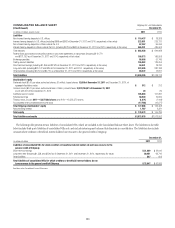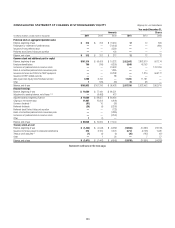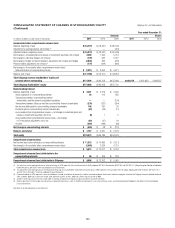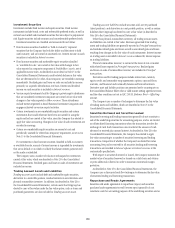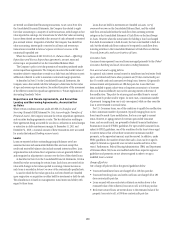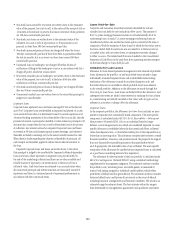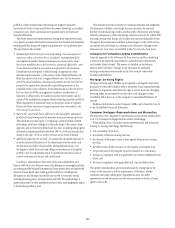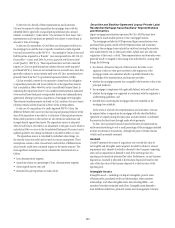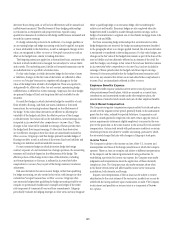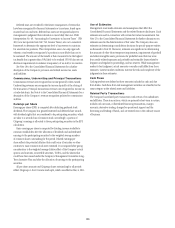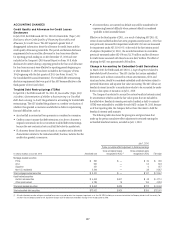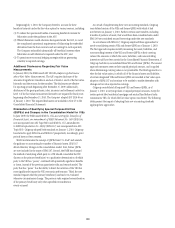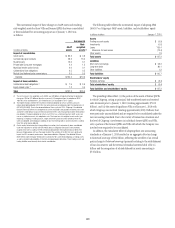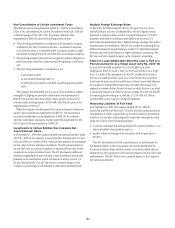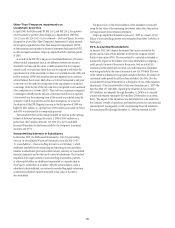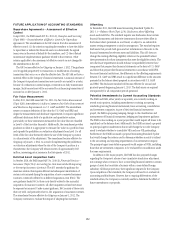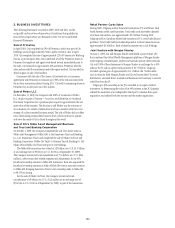Citibank 2011 Annual Report Download - page 165
Download and view the complete annual report
Please find page 165 of the 2011 Citibank annual report below. You can navigate through the pages in the report by either clicking on the pages listed below, or by using the keyword search tool below to find specific information within the annual report.143
In the event of a breach of these representations and warranties,
Citi may be required to either repurchase the mortgage loans with the
identified defects (generally at unpaid principal balance plus accrued
interest) or indemnify (“make-whole”) the investors for their losses. Citi’s
representations and warranties are generally not subject to stated limits in
amount or time of coverage.
In the case of a repurchase, Citi will bear any subsequent credit loss on
the mortgage loan and the loan is typically considered a credit-impaired
loan and accounted for under SOP 03-3, “Accounting for Certain Loans and
Debt Securities Acquired in a Transfer” (now incorporated into ASC 310-30,
Receivables—Loans and Debt Securities Acquired with Deteriorated
Credit Quality) (SOP 03-3). These repurchases have not had a material
impact on Citi’s non-performing loan statistics because credit-impaired
purchased SOP 03-3 loans are not included in non-accrual loans, since they
generally continue to accrue interest until write-off. Citi’s repurchases have
primarily been from the U.S. government sponsored entities (GSEs).
Citi has recorded a reserve for its exposure to losses from the obligation
to repurchase previously sold loans (referred to as the repurchase reserve)
that is included in Other liabilities in the Consolidated Balance Sheet. In
estimating the repurchase reserve, Citi considers reimbursements estimated
to be received from third-party correspondent lenders and indemnification
agreements relating to previous acquisitions of mortgage servicing rights.
The estimated reimbursements are based on Citi’s analysis of its most recent
collection trends and the financial solvency of the correspondents.
In the case of a repurchase of a credit-impaired SOP 03-3 loan, the
difference between the loan’s fair value and unpaid principal balance at the
time of the repurchase is recorded as a utilization of the repurchase reserve.
Make-whole payments to the investor are also treated as utilizations and
charged directly against the reserve. The repurchase reserve is estimated
when Citi sells loans (recorded as an adjustment to the gain on sale, which is
included in Other revenue in the Consolidated Statement of Income) and is
updated quarterly. Any change in estimate is recorded in Other revenue.
The repurchase reserve is calculated by individual sales vintage (i.e.,
the year the loans were sold) and is based on various assumptions. These
assumptions contain a level of uncertainty and risk that, if different from
actual results, could have a material impact on the reserve amount. The
most significant assumptions used to calculate the reserve levels are as
follows:
loan documentation requests;
repurchase claims as a percentage of loan documentation requests;
claims appeal success rate; and
estimated loss per repurchase or make-whole.
Securities and Banking-
Sponsored Legacy Private Label
Residential Mortgage Securitizations—Representations
and Warranties
Legacy mortgage securitizations sponsored by Citi’s S&B business have
represented a much smaller portion of Citi’s mortgage business.
The mortgages included in S&B-sponsored legacy securitizations were
purchased from parties outside of S&B. Representations and warranties
relating to the mortgage loans included in each trust issuing the securities
were made either by Citi, by third-party sellers (which were also often the
originators of the loans), or both. These representations and warranties were
generally made or assigned to the issuing trust and related to, among other
things, the following:
the absence of fraud on the part of the borrower, the seller or any
appraiser, broker or other party involved in the origination of the
mortgage (which was sometimes wholly or partially limited to the
knowledge of the representation and warranty provider);
whether the mortgage property was occupied by the borrower as his or her
principal residence;
the mortgage’s compliance with applicable federal, state and local laws;
whether the mortgage was originated in conformity with the originator’s
underwriting guidelines; and
detailed data concerning the mortgages that were included on the
mortgage loan schedule.
In the event of a breach of its representations and warranties, Citi may
be required either to repurchase the mortgage with the identified defects
(generally at unpaid principal balance plus accrued interest) or indemnify
the investors for their losses through make-whole payments.
To date, Citi has received actual claims for breaches of representations
and warranties relating to only a small percentage of the mortgages included
in these securitization transactions, although the pace of claims remains
volatile and has recently increased.
Goodwill
Goodwill represents the excess of acquisition cost over the fair value of
net tangible and intangible assets acquired. Goodwill is subject to annual
impairment tests, whereby Goodwill is allocated to the Company’s reporting
units and an impairment is deemed to exist if the carrying value of a
reporting unit exceeds its estimated fair value. Furthermore, on any business
dispositions, Goodwill is allocated to the business disposed of based on the
ratio of the fair value of the business disposed of to the fair value of the
reporting unit.
Intangible Assets
Intangible assets—including core deposit intangibles, present value
of future profits, purchased credit card relationships, other customer
relationships, and other intangible assets, but excluding MSRs—are
amortized over their estimated useful lives. Intangible assets deemed to
have indefinite useful lives, primarily certain asset management contracts


